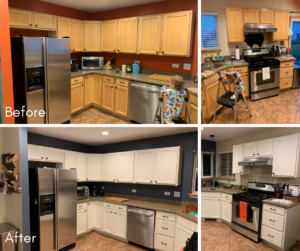 Happy New Year! It’s resolution season and at BAFS, part of my New Year’s resolution is to tackle some of the home projects I have been putting off. The first project I’m going to take you through is one that requires some effort but will make a major impact in your home once it’s completed. Yes, I am talking about your cabinets. I redid my own kitchen cabinets over a year ago and it changed my home dramatically. (Check out the photos for full effect.) Whether you want to overhaul your kitchen or simply need to update your bathroom vanity (which I’ve blogged about recently – check out my previous posts), I’ve got some DIY advice for you.
Happy New Year! It’s resolution season and at BAFS, part of my New Year’s resolution is to tackle some of the home projects I have been putting off. The first project I’m going to take you through is one that requires some effort but will make a major impact in your home once it’s completed. Yes, I am talking about your cabinets. I redid my own kitchen cabinets over a year ago and it changed my home dramatically. (Check out the photos for full effect.) Whether you want to overhaul your kitchen or simply need to update your bathroom vanity (which I’ve blogged about recently – check out my previous posts), I’ve got some DIY advice for you.
Painted cabinets are having their moment. In the past, painting your cabinets meant a very long and laborious practice, primarily because of all the sanding required. There has been progress to help move along the process though. There are now some kits available on the market such as Rust-Oleum Cabinet Transformations and Nuvo Cabinet Paint, which cut out the lengthy sanding process with a quicker deglosser. Now don’t get me wrong, painting your cabinets, especially your kitchen cabinets, is still quite the undertaking, but with the proper preparation and know-how you can make the project much more manageable. Here are some of the things I was glad I found out before and then learned during the process of doing my own kitchen.
Properly clean beforehand. When I redid my kitchen cabinets my first step was to thoroughly clean them. While I was prepping for this project, I read several comments that other DIY-ers had failed to properly clean beforehand and it botched their finished look (i.e. think grease streaks, dust, etc.). I didn’t want this to happen to me, so I busted out my rubber gloves and Lestoil (a heavy duty multipurpose cleaner) and scrubbed (and then scrubbed again) my cabinets until there was no trace of grease or dirt left.
Dismantling & organizing your cabinets. After cleaning, you’ll need to dismantle your cabinets. If you are doing your kitchen or a large bathroom vanity, it is important to ensure that you keep all necessary hardware associated with its particular cabinet door. (This is not necessary if you are redoing a small vanity obviously.) Prior to starting work on my project, I created a master drawing of my kitchen and then numbered all of the cabinets, working from left to right. I then numbered several Ziploc bags and then placed the cabinet’s hardware in said bag as well as used painter’s tape to number each door appropriately.
NOTE: While I was actually painting the tape came off and was then placed to the right side of each door. This is simply an example of how to keep your cabinets organized during the painting portion.
Prepping your work space. Here is where painter’s tape, drop-clothes, sanding (if you are doing it!), and tack clothes come in. Use the painter’s tape to protect surfaces such as countertops, floors, surrounding walls, as well as potentially the insides of your cabinets if you are not painting them. Placing drop-clothes around your working area will reinforce this protection as well.
If you are using sand paper because you have decided to go the traditional prime/paint route, start sanding away, making sure you are going with the grain of the wood. For all-purpose sanding, experts suggest using 100-grit sand paper. Regardless of whether or not you are sanding, use the tack clothes to thoroughly wipe down the area before you put on any primer and/or paint (and then make sure to wipe them down again in between coats).
NOTE: If you have the means, it is helpful during this preparation time to find something to prop your cabinet doors up while they dry. If you leave them on a drop-cloth to dry, not only will it increase your work time but it will also run the risk of sticking to the cloth. One suggestion is to take flat pieces of wood and then have nails go through them so that the pin-prick is jutting out. You will then be able to prop your doors up on a stable surface, allow for faster drying, and diminish the possibility that the door will stick to the drop-cloth.
Priming/Painting/Staining. The time has come for the transformation to begin! With primer and/or paint, personally, I like to start with a thin layer primer/paint to simply cover the area. (I think that thin coats allowed me to control my finish better. I used three coats on the outside of my cabinets and did two on the inside of the door.) Whatever it is you are doing, be sure to work with the grain of the wood and be smooth with your application. Personally, I found that using a brush with a shorter handle gave me more control over the amount of paint I was applying.
Protective Top Coat. If you are happy with your work, now is the time to protect it. This is where a top coat comes in. In a lot of cabinet kits, they provide a top coat. I decided to purchase Minwax Fast-Drying Polyurethane to protect and finish my own cabinets.
How many layers of top coat you need depends on your application. Using more will obviously increase your drying time but may limit your need for additional coats. For me, like with the paint, I used a thin coat, lightly sanded and wiped down my cabinets, did a second, and then third application.
Taking on your (kitchen) cabinets can be a big undertaking, but with some patience and proper preparation, it will be well worth the effort! It was a major transformation in my own home and all for the better, and I know it can be the same for you too.
